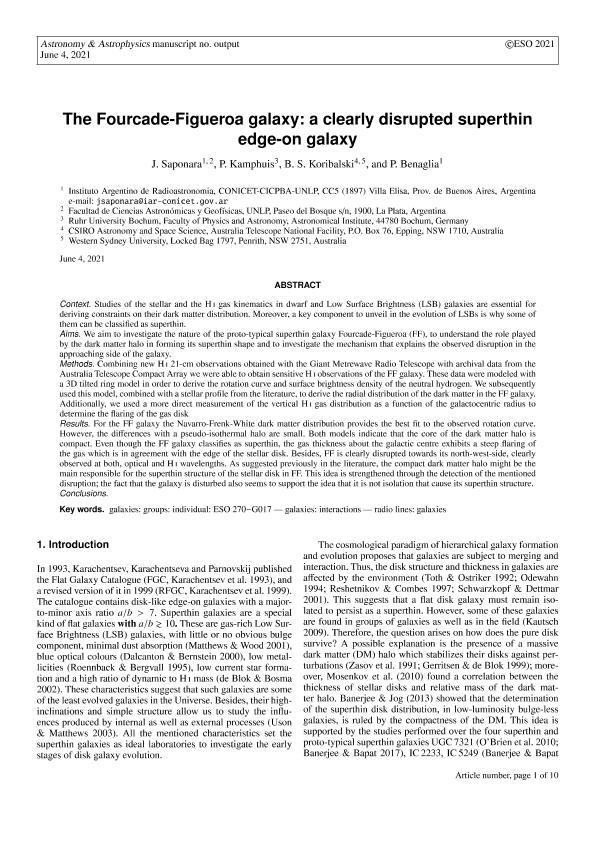Mostrar el registro sencillo del ítem
dc.contributor.author
Saponara, Juliana

dc.contributor.author
Kamphuis, P.
dc.contributor.author
Koribalski, Bärbel

dc.contributor.author
Benaglia, Paula

dc.date.available
2021-08-19T14:27:43Z
dc.date.issued
2021-07
dc.identifier.citation
Saponara, Juliana; Kamphuis, P.; Koribalski, Bärbel; Benaglia, Paula; Fourcade-Figueroa galaxy: A clearly disrupted superthin edge-on galaxy; EDP Sciences; Astronomy and Astrophysics; 652; A108; 7-2021; 1-10
dc.identifier.issn
0004-6361
dc.identifier.uri
http://hdl.handle.net/11336/138517
dc.description.abstract
Context. Studies of the stellar and the HI gas kinematics in dwarf and Low Surface Brightness (LSB) galaxies are essential for deriving constraints on their dark matter distribution. Moreover, a key component to unveil in the evolution of LSBs is why some of them can be classified as superthin.Aims. We aim to investigate the nature of the proto-typical superthin galaxy Fourcade-Figueroa (FF), to understand the role played by the dark matter halo in forming its superthin shape and to investigate the mechanism that explains the observed disruption in the approaching side of the galaxy.Methods. Combining new H i 21-cm observations obtained with the Giant Metrewave Radio Telescope with archival data from theAustralia Telescope Compact Array we were able to obtain sensitive HI observations of the FF galaxy. These data were modelled with a 3D tilted ring model in order to derive the rotation curve and surface brightness density of the neutral hydrogen. We subsequently used this model, combined with a stellar profile from the literature, to derive the radial distribution of the dark matter in the FF galaxy.Additionally, we used more direct measurement of the vertical HI gas distribution as a function of the galactocentric radius to determine the flaring of the gas diskResults. For the FF galaxy, the Navarro-Frenk-White dark matter distribution provides the best fit to the observed rotation curve.However, the differences with a pseudo-isothermal halo are small. Both models indicate that the core of the dark matter halo is compact. Even though the FF galaxy classifies as superthin, the gas thickness about the galactic centre exhibits a steep flaring of the gas which is in agreement with the edge of the stellar disk. Besides, FF is clearly disrupted towards its northwest-side, clearlyobserved at both, optical and HI wavelengths. As suggested previously in the literature, the compact dark matter halo might be the main responsible for the superthin structure of the stellar disk in FF. This idea is strengthened through the detection of the mentioned disruption; the fact that the galaxy is disturbed also seems to support the idea that it is not isolation that causes its superthin structure.
dc.format
application/pdf
dc.language.iso
eng
dc.publisher
EDP Sciences

dc.rights
info:eu-repo/semantics/openAccess
dc.rights.uri
https://creativecommons.org/licenses/by-nc-sa/2.5/ar/
dc.subject
galaxies: groups: individual: ESO 270−G017
dc.subject
galaxies: interactions
dc.subject.classification
Astronomía

dc.subject.classification
Ciencias Físicas

dc.subject.classification
CIENCIAS NATURALES Y EXACTAS

dc.title
Fourcade-Figueroa galaxy: A clearly disrupted superthin edge-on galaxy
dc.type
info:eu-repo/semantics/article
dc.type
info:ar-repo/semantics/artículo
dc.type
info:eu-repo/semantics/publishedVersion
dc.date.updated
2021-08-17T15:53:21Z
dc.journal.volume
652
dc.journal.number
A108
dc.journal.pagination
1-10
dc.journal.pais
Francia

dc.journal.ciudad
Paris
dc.description.fil
Fil: Saponara, Juliana. Universidad Nacional de La Plata. Facultad de Ciencias Astronómicas y Geofísicas; Argentina. Provincia de Buenos Aires. Gobernación. Comisión de Investigaciones Científicas. Instituto Argentino de Radioastronomía. Consejo Nacional de Investigaciones Científicas y Técnicas. Centro Científico Tecnológico Conicet - La Plata. Instituto Argentino de Radioastronomía; Argentina
dc.description.fil
Fil: Kamphuis, P.. Ruhr University Bochum. Faculty of Physics and Astronomy. Astronomical Institute; Alemania
dc.description.fil
Fil: Koribalski, Bärbel. Australia Telescope National Facility; Australia
dc.description.fil
Fil: Benaglia, Paula. Provincia de Buenos Aires. Gobernación. Comisión de Investigaciones Científicas. Instituto Argentino de Radioastronomía. Consejo Nacional de Investigaciones Científicas y Técnicas. Centro Científico Tecnológico Conicet - La Plata. Instituto Argentino de Radioastronomía; Argentina
dc.journal.title
Astronomy and Astrophysics

dc.relation.alternativeid
info:eu-repo/semantics/altIdentifier/url/https://www.aanda.org/10.1051/0004-6361/202140797
dc.relation.alternativeid
info:eu-repo/semantics/altIdentifier/doi/http://dx.doi.org/10.1051/0004-6361/202140797
Archivos asociados
